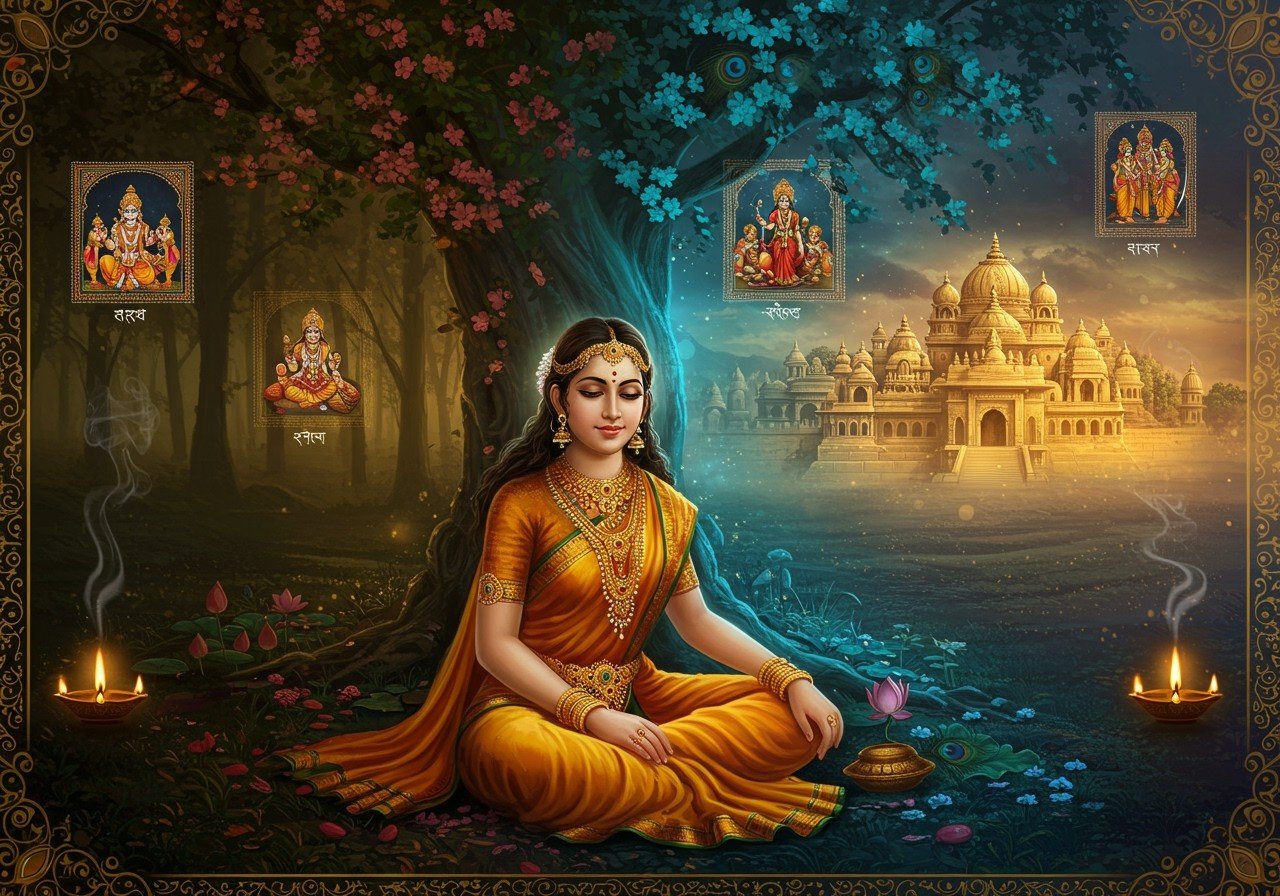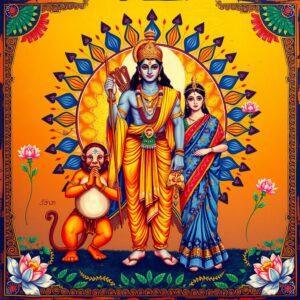
Sita’s exile and return is a profound narrative woven into the Ramayana, holding immense cultural and spiritual significance. It embodies values of devotion, duty, and resilience, resonating deeply with those who cherish tradition. Understanding Sita’s journey offers valuable insights into Indian customs and beliefs, particularly for those seeking authenticity and convenience in their spiritual practices. This exploration will highlight the significance of these themes and their relevance in contemporary life.
The First Exile: A Test of Devotion
Sita’s journey begins with her voluntary exile alongside Rama and Lakshmana. Dharma, the principle of duty, plays a pivotal role in the Ramayana, guiding the actions of its characters. King Dasharatha’s promise to Queen Kaikeyi led to Rama’s exile, and Sita, unwavering in her devotion, chose to accompany him, demonstrating profound sacrifice. This exploration of Ramayana characters and life lessons provides further context to the epic and its figures.
The forest symbolizes trials, tribulations, and ultimately, transformation. Sita’s steadfast devotion to Rama exemplifies ideal companionship, solidifying her status as a revered figure in Indian tradition. This period of exile showcases her unwavering love, duty, and resilience, qualities that continue to inspire those who value tradition and authenticity. For a deeper understanding of Dharma’s significance, explore this thematic exploration of Dharma in the Ramayana.
The Second Exile: Resilience in the Face of Adversity
Sita’s second exile commences after Rama’s return to Ayodhya and coronation. Despite her proven purity through Agni Pariksha, societal pressures and public opinion compel Rama to banish her. This act underscores the challenges women faced in patriarchal societies, where public perception could influence even the most personal decisions. You can find more on the timeless lessons from the Ramayana here.
Alone, pregnant, and exiled, Sita’s strength and resilience shine through. She seeks refuge in Sage Valmiki’s hermitage, where she gives birth to and raises her twin sons, Lava and Kusha. This period highlights Sita’s fortitude and mirrors the broader theme of women’s resilience throughout history. This exploration of women in the Ramayana delves deeper into their strength and relevance.
The Final Departure: A Testament to Dignity
Sita’s final departure from Ayodhya is a moment of profound emotion and spiritual depth. Love, duty, and sacrifice intertwine as she chooses to return to the earth, symbolizing a return to her divine origins. This act of liberation asserts Sita’s agency and leaves a lasting impact on Rama and the kingdom. It resonates powerfully in contemporary discussions about women’s rights, self-worth, and empowerment.
This final act transcends personal choice; it is a powerful message reflecting Sita’s enduring influence on Indian culture and thought. It serves as a testament to her unwavering dignity and serves as an inspiration for generations to come. Explore more about the Ramayana’s influence here.
Lessons from Sita’s Story: Timeless Wisdom for Modern Life
Sita’s story offers invaluable lessons for contemporary audiences. Her resilience in the face of adversity is a powerful source of inspiration, underscoring the importance of staying true to one’s principles and values. The narrative encourages reflection on the interplay between societal expectations and personal desires and highlights the importance of women’s roles and empowerment. Here’s more information about the Ramayana’s cultural influence.
Culturally, Sita’s story holds immense significance, celebrated in festivals and rituals worldwide. Her tale continues to inspire devotion and serves as a testament to the enduring strength of the human spirit. Through Sita’s journey, we gain insights into timeless values that continue to guide and inspire those who cherish tradition. Hanuman’s journey of devotion and strength provides another powerful example of these values in the Ramayana.
How Poojn.in Supports Your Connection to Sita’s Story
Poojn.in offers a wide selection of authentic puja items and materials to honor Sita Mata. We provide pure copper kalash and thali sets, essential for traditional rituals. Our collection includes:
- Pure cotton vastras (cloths) in red and white, traditionally used in Sita puja. These are available in various sizes and designs to suit your needs.
- Handcrafted Ram Darbar murtis (statues) made by skilled artisans, ensuring the highest quality and reverence. Choose from different materials like brass, marble, and wood.
- Natural kumkum and haldi (turmeric) for ritual offerings, sourced directly from trusted suppliers.
- Traditional brass diyas (lamps) and pure ghee for aarti, enhancing the spiritual atmosphere of your puja.
- Tulsi mala (beads) associated with devotion to Rama and Sita, perfect for meditation and prayer.
We source our products from trusted vendors who uphold traditional standards. Each item undergoes rigorous quality checks. For special occasions and temple ceremonies, we offer complete puja kits. Our customer service team can guide you in selecting the right items. Visit poojn.in or call our toll-free number for more information.
You can also explore other relevant products on poojn.in, such as Ladoo Gopal Murtis, Radha Krishna Murtis, and Pure Cotton Sarees for puja offerings. Additionally, find traditional puja items like Tulashi Herbal Alta.
Conclusion: Sita’s Enduring Legacy
Sita’s story is a testament to devotion, resilience, and the power of inner strength. Her journey, marked by trials and triumphs, reflects the enduring strength of women in the face of societal challenges. Sita’s unwavering commitment to her values, even in adversity, provides timeless lessons for all.
Her story reminds us to balance societal expectations with personal beliefs and encourages reflection on women’s roles and empowerment. As we honor Sita through rituals and festivals, her legacy continues to inspire. Her enduring influence on Indian culture reminds us of the power of courage, dignity, and devotion. Sita’s journey is not merely a tale of the past; it is a guiding light for those seeking strength and inspiration in tradition.
FAQs on Sita’s Exile and Return
Why did Sita go to the forest with Rama? Sita’s decision to accompany Rama to the forest stemmed from her deep devotion and sense of duty. Her voluntary exile demonstrates her unwavering support and love for her husband, a testament to the strength of their bond.
Why was Sita exiled a second time? Sita’s second exile was a consequence of societal pressures and doubts regarding her purity after her abduction by Ravana. Despite proving her innocence, she chose to leave Ayodhya to protect Rama’s honor and maintain the kingdom’s stability.
Why did Sita ultimately leave Ayodhya? Sita’s final departure from Ayodhya was a powerful assertion of her agency and dignity. Choosing to return to the earth, her divine origin, she prioritized her self-worth and set an example of empowerment for generations to come.
What lessons can we learn from Sita’s experiences? Sita’s story is a wellspring of wisdom, offering lessons on devotion, resilience, sacrifice, and the importance of staying true to one’s values in the face of adversity.


